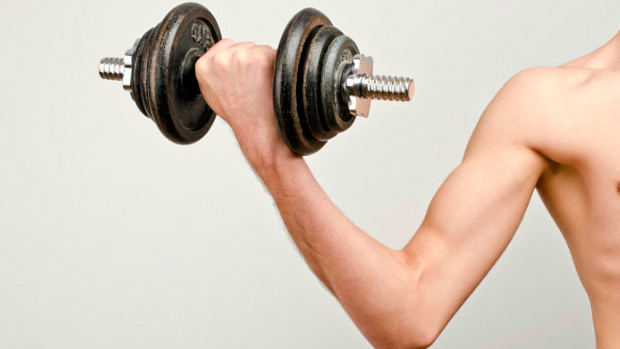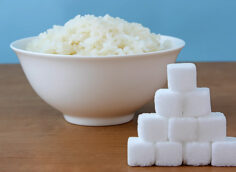You know the type. Small. The T-shirt they wear on bench press day reads: "185 Club." They blame their thinness on genetics and euphemistically refer to each other as "hard gainers." They lift six times per week and eat tuna and rice three times a day. They are the BONEHEADS OF BODYBUILDING.
Hey, I'm not being judgmental, I was a bonehead, too. I just want to waft the coffee fumes in everyone's direction. There are definite nutritional pitfalls that we all fall prey to – and the ones who succumb most frequently are the boneheads who stay small. In fact, you may know someone who has never graduated from this group of self-defeating stick figures.
Let's take a gander at some of their mistakes...
Listen, I weighed in at a whopping 155 when I graduated from high school, despite regular intense lifting. Free weights, pulleys, machines: you name it, I used it. I also trained my butt off daily at tae kwon do, track practice, and swimming. After a few years of consuming Weider mags and following the advice of pro bodybuilders, I was ultra-disciplined. And a bonehead.
My problem was that I was so focused upon physical training that food was a secondary concern. Oh, I controlled my diet – when I was actually eating. But when does one sit down to eat while in school and performing two or three different training sessions every day? It wasn't until I cut out two of my four physical endeavors that I accidentally started to gain weight. Finally, the energy balance equation was leaning in my favor.
There are other boneheads, of course, who do the opposite. They think that their training – no matter how brief or mediocre – allows them to eat garbage ad libitum (whenever they want) and so commit little thought to it. Bad call. Training changes one's body right down to the sub-cellular level over time, but these adaptations create all new demands. They don't allow or excuse poor dietary practices. The "see-food diet" may feed the machine but it fails to do so properly.
Whether it's an over-emphasis on training or an under-emphasis on food choices, lack of equal attention to diet can be a bodybuilder's downfall. Many are too busy to identify this pitfall so they continue to train their asses off, but remain small and/or soft. Even those who know better often don't commit. Is this YOU? Be honest with yourself. Optimal nutrition is just too bloody time consuming and uncomfortable to maintain.
But let's not over-obsess about diet; that's a loser-move as well...
Ten years ago, my diet was basically fat free yogurt, skim milk, tuna and spaghetti. I had all the discipline in the world and yet it was backfiring on me. I avoided fat like the plague and wouldn't even consume anything with over 300 mg of sodium. Believe it. It was a classic case of a neophyte bodybuilding bonehead over-applying health information. My family had no history of cardiovascular disease. I had all of 6% body fat from endless workouts. Yet I was hell-bent on "eating right."
Boneheads who learn just enough to hurt themselves get no variety. They tend to over-consume some nutrients while under-consuming others. Have you ever considered that? Do you eat just five or six foods repeatedly while eschewing all others as "bad?" The more you learn about nutrition, the more you'll realize the vast number of nutrients and interactions that are required for health. And fitness creates even greater demands. Micro-managing your diet by consuming some exotic herb or micromineral supplement won't fix matters. That's like putting a Band-Aid on a bullet wound. We could get clinical-sounding and call deluded dietary discipline "inadequate nutrition support" but we'll simply call it lack of "high octane" fuel.
Of course, getting enough fuel and variety isn't just an issue when you're hungry...
When training, recovery and supplements are optimized, the stage is finally set for growth. But what is "optimized" anyway?
We can review a simple glucose tolerance test for a clue. After ingesting 75 grams of glucose, it's clear that blood sugar and insulin levels fall significantly by two hours after the "meal."(3) The pancreas responds to the carbohydrate (and, in mixed meals, to the amino acids and fats also) and by the time we're 120 minutes "post-prandial" our most anabolic hormone has ebbed and the tide of circulating nutrients has subsided. Thus, eat every two hours or so to keep the anabolic environment primed.

But what if you're not hungry? I don't care. A famous (and freaking HUGE) pro bodybuilder once said, "The real battle in bodybuilding is the one with the knife and fork." Amen.
Plus, the data don't lie. The numbers on the graph may be obvious to some readers but we all need to be reminded of the practicalities sometimes. Just as thirst lags behind physiological needs, so does hunger – at least for the size-craving bodybuilder. After two hours it's time to eat again. Scheduled eating is especially critical before and after a workout. Try drinking some of your calories if you must. Set an alarm wrist watch if you must. Time (and growth) waits for no one. If you have to wait until three or four hours have passed, you're forgiven... this time.
In stark contrast, however, some boneheads skip breakfast after an eight-hour fast. A quick cup of java and it's off to work... it's blaspheme. What do you think is keeping you alive, coffee boy? Where do you think blood glucose comes from after an eight-hour snooze and a morning of fasting? Your ever-charitable liver has done its best pumping out glucose but its stores of glycogen have fallen overnight. And even if you were willing, your muscles lack the enzyme to help donate blood sugar directly from their glycogen reserves (glucose-6-phosphatase, for those who care).
That leaves the screaming cortisol concentrations in your morning bloodstream to play smack-down on your muscles. Can anyone say "proteolysis?" How about "alanine efflux?" Listen, your body will do whatever it takes to maintain glucose availability and keep you alive – including chew-up muscle. Be afraid. Be very afraid.
There are other physiologic examples of why fasting beyond a few hours is a no-no, but I think the point has been made. Waiting on hunger is for boneheads.
And so is blaming your size on genetics...
Try as I might, I was unable to make serious gains when I was in my late teens and early twenties. It would have been easy to blame my parents for creating me from the shallow end of the gene pool but that wasn't my problem. I was a victim of the laws of thermodynamics. Yes, they hold true for bodybuilders too.
Energy is neither created nor destroyed – it just changes form. So why not convert it into muscle mass? (Granted, this is a simplification but energy balance is critical.) Here's an idea. Seriously focus on increasing your food consumption while keeping a diet log. Then after a week, assess your intake. Did you really eat more? There are free (university) diet analysis calculators all over the Web. Use them. (Type "diet analysis" into a search engine like Yahoo or Google to find them.)
If your kcal intake is indeed up, maintain it for a month and then assess your weight gain. Did you put on two or three pounds? If you're not gaining weight, try eating more! Don't just blame your genetics. Ultimately, physics dictates that you WILL gain weight at some point! If a third of it is fat mass, tolerate it for now. You've still acquired that elusive grail of MORE MUSCLE and hopefully STRENGTH. You can think about slowly removing the slight fat gain later. Getting huge and shredded simultaneously is for heavy drug users only, not ectomorphic young guys struggling to scrounge-up 40 bucks for another can of whey protein. It's generally not good to attempt improvements in both concomitantly.
Identifying oneself as a "hard gainer" is a copout. Although genetic predispositions for acquiring muscle mass certainly exist, they do not dictate your size. Strength appears to be about 30% attributable to genetics and 37% due to environment.(2) In other words, your environment appears to be a bigger deal. Similarly, genetic contributions to body composition (like obesity) have been estimated to be about 25% of the picture while (non-cultural) lifestyle factors account for about 45%.(1)
When I lecture, I call this the "pie graph of hope" because it puts progress within a person's control. Of course, such numbers are controversial but we can certainly say that environment (eating, training, recovery) weighs-in substantially. Use it to your advantage and stop having your little hard gainer support group meetings at the gym.
But all of this pales if you don't keep trying...
This is the biggest bonehead maneuver of all.
Nothing you read on T-mag will do you a bit of good if you don't follow through with it 100 percent. Time to lie back on the psychiatric couch and tell the truth: Have you ever failed to fully complete a new diet or training regime? C'mon... be honest with yourself. Chances are you have – and you probably don't feel much satisfaction from your half-assed attempt. Life's too short to waste time on mediocrity. People only feel good about an effort when it's 100 percent. Then, regardless of whether you win or lose, you've got a critical answer about what works (or doesn't work) for you.
In order to better commit, try a little behavior modification technique I learned back at good ol' SDSU. Write down what you plan to do on a calendar. Show it to other people who will grill you for failing. Make it known that you WILL complete your goal. Print-up and sign a self contract that has real consequences of some kind. Stick post-it notes on your bed stand reminding you to eat. Post them in your car reminding you to eat. Aggressively focus on keeping-up your dedication until 11:59 PM of the very last day you've got charted. You'll be glad you did. (By the way, the same can hold true for training strategies.)
I've learned my lessons. Have you? Over the past ten years I've made some decent progress in turning a bonehead 155-pound kid into a wised-up 205-pound grownup. Being rather ectomorphic by nature, that's pretty good. Just to recap, here's how I graduated from being a bonehead...
- I stopped over-emphasizing training and daily schedule at the expense of nutrition; I made time to eat.
- I traded my obsessive discipline and limited food choices for a much wider variety of foods.
- I ate (at least usually) on a two- three hour schedule – especially when I wasn't hungry.
- I refused to brand myself a "hard gainer."
- I maintained the effort with as few relapses as possible.
And so ends this treatise on nutritional bonehead-ism. So good luck, classmates. And remember, we graduate from being a bonehead on a daily basis. Anyone can return; make sure it isn't you.
- Bouchard C et al. Inheritance of the amount and distribution of human body fat. Int J Obes. 1988;12(3):205-15.
- Perusse L et al. Genetic and environmental sources of variation in physical fitness. Ann Hum Biol. Sep-Oct 1987;14(5):425-34.
- Sexton T et al. Effects of eccentric exercise on glucose kinetics and insulin concentrations in resistance-trained athletes. O J Sci (Med Biol.) 2001;101(1):13.




